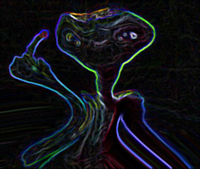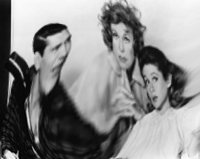2. What are the Richards Criteria?
3. Who are you?
• 4. What is the Popular Interpretation?
5. And the Texas/Bush School?
6. Can you summarize the Technosexual Reading?
7. How about the Richards Posttranssexual Rereading?
8. What's the story with the fan fiction and the double murder?
9. Who am I?
4. What is the Popular Interpretation?
When it made the rounds of the poetry discussion lists, “Hypertext” was an immediate hit with the Language and Post-Language poets and critics, who hailed the poem's anti-linearity, “disjunctive collage narrative,” and “subversive, postcapitalist rejection of repressive grammar and normative syntax.”
With its shifting viewpoints, ambiguous pronoun references, and kaleidoscope of topics and images, the poem affirms and empowers the reader in the production process, said the Langpo people, because the reader must supply the connections between all these disparate elements to make the text cohere. Through this process, the reader becomes aware of the text's cultural frames and socially- determined nature, leading of course to worldwide socialist revolution.
While the revolution remains incomplete, the social constructedness of “Hypertext” was opened up to a wider audience by what became known as the Popular Interpretation, pioneered during the “missing years” of author Alan Richardson (FAQ #5) by then-unknown MFA student Ellen Richards. The clever, persuasive Richards built her meteoric reputation with her close reading of “Hypertext,” aided by the widespread collaboration of armchair critics on the Internet, including many of you with your vast knowledge of TV, your film savvy, and your search engines.
Fellow students at the Iowa Writers Workshop described Ellen Richards as pretty, slender, and narrow-hipped, with a wicked sense of humor and a falsetto voice that cracked occasionally at post-workshop happy hours into a deep, lusty laugh. Even prominent mainstream academics such as Richard Allman were drawn to Popular ideas before turning against Richards in the wake of the emerging biographical details (FAQ #5, FAQ #6, etc.), i.e. the real-life scandals that constantly threatened to divert attention from the poem itself.
According to Richards, the poem self-consciously embraces the artifacts of Western popular culture while revealing a pattern of underlying sexual tensions. Re: (regarding, in reference to) ...PR-type hype points the poem from the outset to the rhetoric of popular-media fan sites on the Web (per HTTP, via HyperText Transfer Protocol).
The Perth Repertory in Scotland is where actor Ewan McGregor got his start by pulling curtains backstage, well before he achieved fame as Obi-Wan Kenobi in the Star Wars prequels. You can see Ewan naked (Peer here:) in his breakout role in Trainspotting (1996); for a lengthier look at his uncircumcised penis, try The Pillow Book (1996).
Line 3's ET refers both to the long-running, syndicated Entertainment Tonight, TV's first fan show and leading self-reflexive look at Hollywood (pet yer petter), and to Steven Spielberg's wacky, cuddly, asexual E.T. in E.T., the Extra-Terrestrial (1982). In one of numerous segments leading up to the 20th anniversary re-release of the film (“E.T. on ET,” “ET on E.T.,” etc.), Entertainment Tonight showed never-before-seen footage from the DVD that seemingly confirms the acidity of E.T.'s urine.

The otherwise-dickless alien appears to relieve himself in the bushes (thee pee there) with a steaming stream of vinegar; super slow motion shows the corrosive effects on the foliage. Household vinegar has a pH of 3.0 (three), versus normal human urine (4.6 to 8.0).
The second stanza's enigmatic dialogue inscribes fanzine discourse in the larger context of the dominant Western literary and philosophical tradition and serves to level the playing field between high and low culture. Trey Parker, heartthrob co-creator of South Park, is the postmodern, scatological extension of animated cartooning's first modernist and wildman, Tex Avery.

Avery's ornery characters Porky Pig, Daffy Duck, and Bugs Bunny responded to Disney sentimentalism and repressed sexuality with irony, sarcasm, slapstick, and violence, and they called attention to the artifice of the cartoon by speaking directly to the audience, questioning the plot, or jumping out of the credits (cf. FAQ #3, FAQ #9). Parker's Ex-girlfriend is said to be the model for Wendy Testaburger, the character who makes South Park boyfriend Stan Marsh barf every time she speaks (Tee-hee!).

Therefore, said Richards,
The giggling Hetty Eyre combines
that subtle Comedy Central reference (he, her hyper/ Ex
= Trey Parker) with the more obvious allusion to Charlotte
Bronte's Jane Eyre.
Jane Eyre is one of the few literary or media icons not lampooned by Avery
or fucked by South Park's Chef (Isaac Hayes), whose conquests
range from Cleopatra and Virginia Woolf to Lois Lane, Princess Di, and
Kathie Lee Gifford. Pretty tree expert alludes to Bronte's
hyperbolic natural imagery, as when the withering, groaning chestnut tree
gets split by lightning in reaction to Rochester and Jane's engagement.
In Line 6 the poem drills deeper into the Western canon when Hetty turns from Tex the modernist to address Pere Peter, i.e. Pere Peter Abelard, the 12th-century rhetorician, dialectician, teacher, and fornicator who paid for his love with his testicles. Often considered the first modern thinker for questioning early Church orthodoxy, Abelard is even better known for diddling his teenage student Heloise, then marrying her in secret after she got pregnant.
When circumstances drove them apart, the famous couple exchanged steamy letters that have inspired generations of lovers and artists (after eight centuries on the bestseller list, The Letters of Abelard and Heloise recently still ranked 16,802 on Amazon.com).
It was young Heloise's uncle who had Abelard's balls cut off; he hired thugs to perform the crude, transformative surgery. Thus Hetty's “Try rye...” is a sly put-down that refers to the grain-growing monasteries of northern France where Pere Peter retired as a eunuch to pen those famous missives.
If Abelard's scholarly work is the precursor to modern scientific rationalism and foundationalist thinking—and if the unleashed Tyrannosaurus Rex of Spielberg's Jurassic Park (1993) embodies science, and the elite social structures it empowers, gone berserk—then, according to Richards and her followers, Hetty's rhetorical question “Tether T-Rex yet?” really asks, “Have the excesses of empiricism been tamed?”
In this reversal of hegemonic power relations, the hybrid Wendy Testaburger/Jane Eyre sarcastically surmounts Father Abelard, the male symbol of intellectual history. As Richards observed, “The once-lusty Father is left with his twig but loses his berries.”
In the final triplet, the poem circles back to the sexually charged airwaves of contemporary cultural artifacts, now with a darker, more meditative twist. Exert petty hex recalls Bewitched, that epitome of 1960s situation comedy about an advertising executive (Darrin, played by Dick York) married to a witch (Samantha, played by Elizabeth Montgomery) whose mother (Endora, played by Agnes Moorehead) is always trying to break them up, often by putting hexes on hapless Darrin.

Samantha struggles to keep her witchcraft and the lurking subculture of wizards and warlocks secret; to hide her real identity and act as a normal, doting housewife; and to follow Darrin's proscription against using her nose-twitching magic powers—all metaphors for closeted homosexuality. Indeed, the gay actors on Bewitched included lesbian Agnes Moorhead, Paul Lynde as Uncle Arthur, and Dick Sargent, who replaced ailing, drug-addicted Dick York as Darrin in season 6—a transition dubbed by Richards as “the change of Dicks.”
Meanwhile the body bags were piling up in Vietnam. Bewitched episode 93, in which Endora conjures up a dream car for Darrin (still Dick #1) that turns out to be stolen, aired in January 1967, the same month The Doors released their first album with “Light My Fire” (...our love becomes a funeral pyre). Thus, according to Richards,
the “pyx pyre” text
is a complex trope that conjoins two charismatic, subversive, and incendiary
historical figures by linking the lyrics of Jim Morrison to history's
first celebrated book burning in 1121, when church fathers torched Peter
Abelard's Theologia.
Morrison's dark lyrics mirrored the social tensions of the 1960s, including
the drug culture, antiwar movement, and sexual revolution—all conspicuously
absent from Bewitched, whose typical “Another Day at the
Office” plot [vs. FAQ #3—Ed.]
revolves around Darrin securing a big client for his white-bread advertising
agency.
Followers of the Popular school debate whether Line 7's imperative verbs exert and retype are directed at the reader or, reflexively, at the speaker of the poem him/herself. Richards favored the latter view, suggesting that the poet of “Hypertext” is “complicit with all the producers of cultural artifacts, from Abelard to Bewitched and The Doors, in exerting a hex upon the reader and retype-ing a text for popular consumption.” Most agree, at the least, that the tension between Bewitched and The Doors in Line 7 reflects the social divide of the late 1960s.
The Doors are also featured on the soundtrack of Francis Ford Coppola's Apocalypse Now (1979), which opens with chemical-weapon-laden helicopters flying at treetop over the jungle accompanied by Morrison's apocalyptic “The End.” Based on Joseph Conrad's Heart of Darkness, Coppola's film offers, Richards argued,
...one of the most intriguing reactions to the Vietnam
War, which so obsessed American consciousness after the Viet Cong's pivotal
1968 Tet Offensive cracked the collective smugness (the
succinct phrase Tet Rx deftly captures the social prescription
required to treat the sickness of Vietnam).
They pry teeth suggests that American soldiers in Vietnam were
like the Nazis, a comparison encouraged by Coppola's genocidal Colonel
Kurtz (Marlin Brando). Kurtz's pursuit is the Oedipal journey of Captain
Willard (Martin Sheen), whose riverboat crewmembers, suffering the various
ills of a (Bewitched-like) family melodrama, provide the subtextual
link between sexual dysfunction and violence.

“I love the smell of napalm in the morning,” deadpans Lt. Colonel Kilgore (Robert Duvall) after blowing away a Vietnamese village including a playground full of schoolchildren (ether prey....).
The victims of the war were pre-Pyrex, with the well-known Corning high-temperature ovenware product symbolizing the ironic transformation of Vietnam to a free-market economy increasingly dominated by consumer goods and commodity fetishism. In the postwar, globalized Vietnam, those products were given away on a state-sponsored version of Wheel of Fortune, complete with a Southeast Asian Vanna White (Phan Thu Hang) and a Las Vegas wheel shaped like the national-trademark conical straw hat (hence the show's name, The Magic Hat).
Finally, Richards noted that Magic Hat is also the name of a Vermont specialty brewery that makes a beer called “Heart of Darkness.” Therefore, in the relentless logic of the Popular Interpretation, Magic Hat's corporate motto, “Where Ancient Alchemy meets Modern-day Science,” might also be the anthem of a poem in which 12th-century Abelard and Heloise meet Darrin and Samantha, and Stan Marsh and Wendy Testaburger, and all become word phrase puzzles on a Vietnamese Wheel of Fortune.
Yep, in “Hypertext” art and knowledge and repressed sexuality have been transformed into beer names and questions for TV games, the ubiquitous postmodern kitsch of popular culture—and the journal Death of the Author named Ellen Richards Critic of the Year.
.